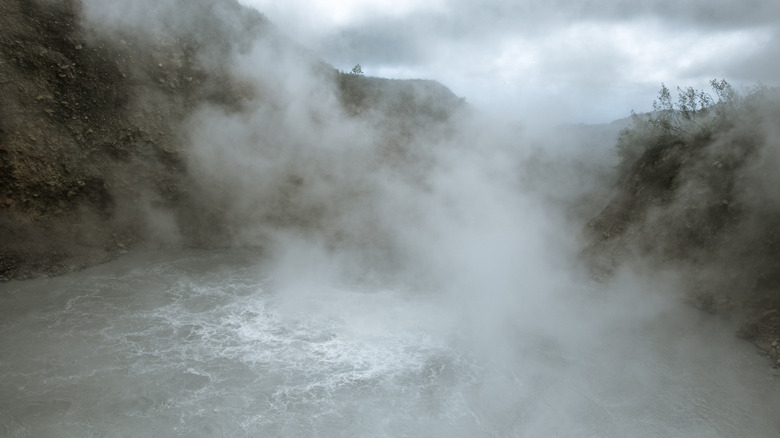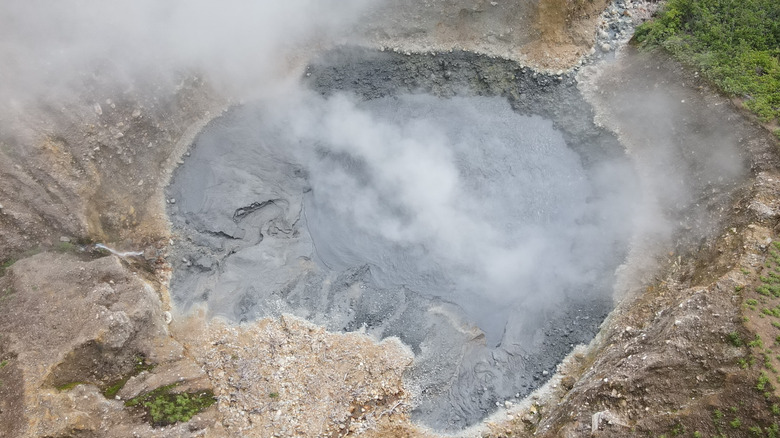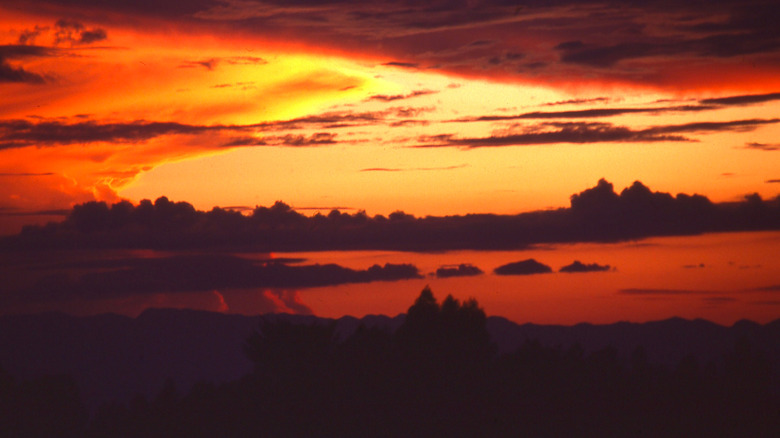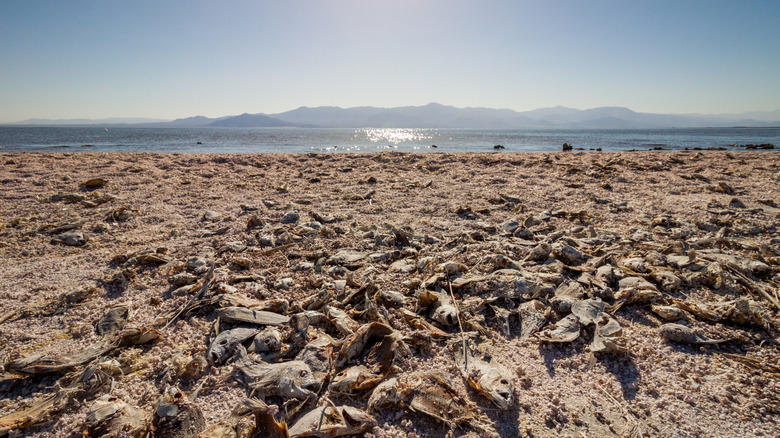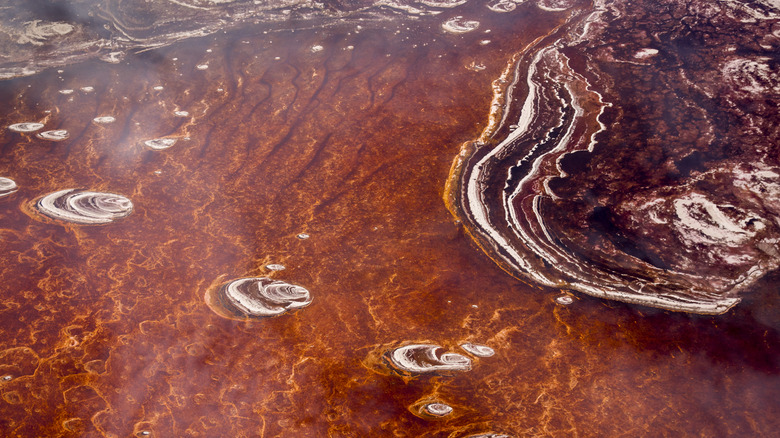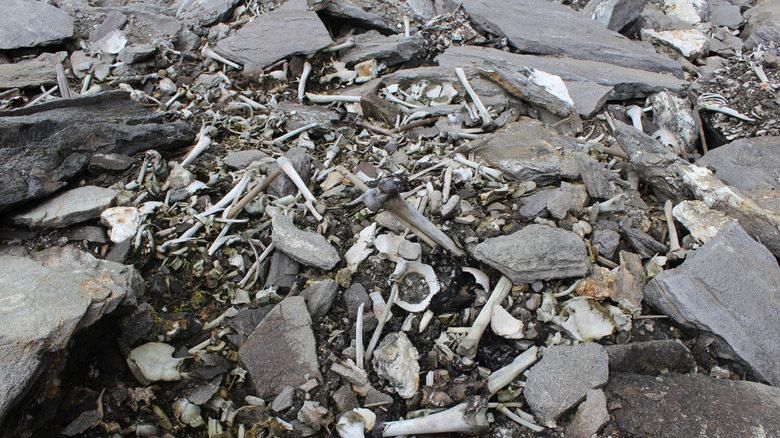The World's Creepiest Lakes You've Never Heard Of Before
When you think of a lake, you most likely picture a pristine body of water where you can swim and splash around with friends, picnic on the shore, fish, boat, and maybe even do a little water skiing. But there are some lakes scattered across the globe where fun in the sun isn't on the schedule. Certain bodies of water, like Boiling Lake in Dominica, are even too dangerous to touch, much less enjoy a swim in. A few are potentially explosive, such as Lake Kivu, located in Africa, which is a deadly bomb in the waiting due to its potential to release clouds of toxic gas. California's Salton Sea, which is actually a lake, is both extremely salty and is also heavily contaminated with agricultural chemicals, with a shore littered with dead fish and the remains of a once vibrant resort.
Then there are other lakes that are both dangerous and seriously scary. The red-hued Lake Natron in Tanzania has water so caustic it can cause burns and is known for mummifying any creatures that die there. Finally, there's Roopkund Lake in India, known as the lake of skeletons for its hundreds of human remains that are visible when the snow melts on this mysterious Himalayan body of water. You're probably not going to want to picnic there.
Boiling Lake is too hot to touch
The Caribbean Island of Dominica boasts gorgeous white and black sand beaches with crystal blue water, but in the country's interior, which is mountainous, forested, and contains active volcanoes, you'll find a less inviting body of water called Boiling Lake. The name is an apt description. Found near the Valley of Desolation, this flooded volcanic steam vent with boiling water and a veil of steam, is very dangerous. The water can reach a scalding 194 F. Falling in would result in third-degree burns and possibly death.
While Boiling Lake is only the second largest lake of this kind — the biggest is Frying Pan Lake in New Zealand — it's definitely the creepiest due to its remote location and its many associated dangers. Over the years, people have died on the rugged trails trying to reach the lake and from the lake itself. Two people died in 1901 when Boiling Lake's water level went down and it spewed out toxic gas that asphyxiated them. You might want to stick to the beaches.
Lake Kivu could explode
Lake Kivu, located between Rwanda and the Democratic Republic of the Congo in Africa, hides a deadly secret. It has the potential to explode in what's called a limnic eruption that happens in certain lakes when trapped toxic gases held in check by water pressure suddenly give way and explode, releasing a killer cloud. It hasn't happened at Lake Kivu in a few thousand years, but it did happen at two different lakes in Cameroon in the 1980s that killed nearly 2,000 people along with livestock.
In the case of Lake Kivu, its size, around 1,000 square miles, and the massive amount of carbon dioxide, methane, and sulphuric acid contained within the lake, present a potentially much deadlier outcome than what occurred in Cameroon in the 1980s. There are millions of people living in the area of the lake who could be in danger of dying by asphyxiation if the lake ever erupted and released a gas cloud. This ticking time bomb could be set off by an earthquake or volcanic eruption.
The Salton Sea is a toxic lake
Unlike some creepy lakes that were born of nature, the Salton Sea in Southern California is a manmade disaster. The lake, which is the largest in the state at nearly 350 square miles, formed in 1905 when the Colorado River overflowed irrigation canals and poured into part of a desert basin, creating the lake. For many years, the Salton Sea was the site of various resorts, but today it features decaying fish and near ghost towns like Bombay Beach. The Salton Sea is a terminal lake, meaning no water flows out. It's also a stew of high salinity due to evaporation as the lake dries up, and it contains tons of industrial agricultural chemicals from nearby farmland.
The lake often releases clouds of chemical-laden dust, causing poor air quality. Although there is still some aquatic life, an estimated 97% of the fish population has died off. Dead, rotting fish now cover the shore in some areas. Likewise, where there was once a bustling resort scene that boasted fishing, boating, and swimming, you'll find abandoned buildings and a haunting atmosphere.
Lake Natron is red and caustic
Tanzania's Lake Natron, located near the African country's border with Kenya, is a unique body of water for many reasons, but not one you'd want to take a dip in. The water is highly alkaline with a pH level that sometimes borders on what you'd find in household bleach. Swimming there could cause severe burns. Additionally, the water often has a reddish hue from a type of red algae that thrives in this environment.
But what makes Lake Natron even creepier is the water's ability to mummify the corpses of animals that die in or near the water. The lake contains high levels of natron, a type of sodium carbonate that not only gives the lake its name, but was what the Ancient Egyptians used in their mummification process. Animals that die in or near the lake often become desiccated from soaking in the natron that absorbs fluids and fat and leaves behind preserved bodies. There is some wildlife in this inhospitable environment, including tilapia adapted to living in the lake and thousands of pink flamingos that go there to breed. Still, Lake Natron has a very eerie feel to it.
The mysterious remains of Roopkund Lake
High in the Himalayas, at the foot of one of India's tallest mountains, Trisul, lies bone-filled Roopkund Lake. While it's often covered in snow, it sometimes melts, and this is when it reveals its dark secret. Scattered in and around the lake are hundreds of human skeletal remains. It's been estimated that up to 800 people died there. In some cases, among the scattered bones, flesh still remains, and others are even better preserved, making for a macabre scene. How these people ended up there is a mystery. Things got even stranger when scientists did a DNA study of 38 of the skeletal remains in 2019.
The scientists discovered that there were both men and women who were from three distinct ethnic groups and that they had died at the lake at different times in history. The earliest, who were of South Asian descent, died there around 800 AD. The researchers believe they may have been Hindu pilgrims going to a shrine of the mountain goddess Nanda Devi. The other group, who died there around 1800 AD, included people of Eastern Mediterranean descent and one of Southeast Asian descent. How they died is also a mystery. The study could only determine that they didn't likely die in an epidemic. The lake of the skeletons remains a disturbing mystery. It's just one of the lakes in the world that's anything but ordinary and is definitely creepy.
